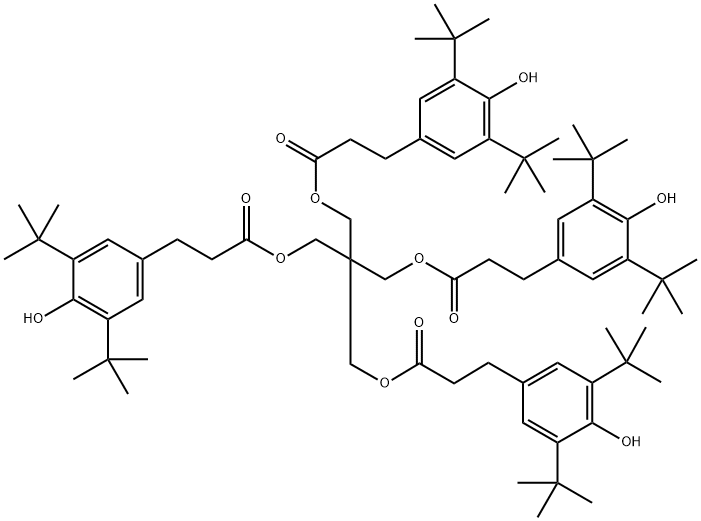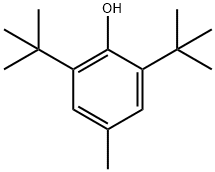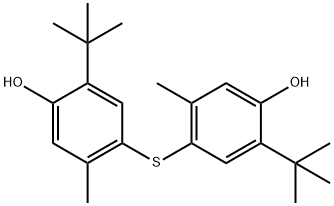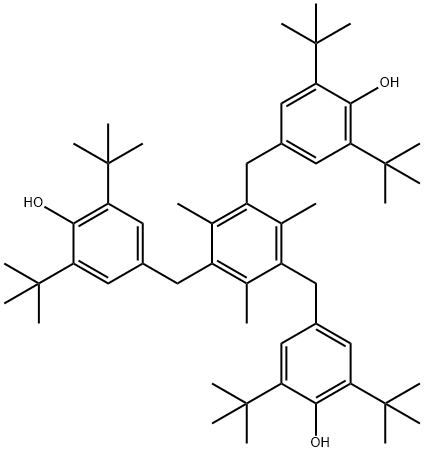Antioxidant 1726
- CAS NO.:110675-26-8
- Empirical Formula: C33H60OS2
- Molecular Weight: 536.96
- MDL number: MFCD11973660
- EINECS: 438-600-3
- SAFETY DATA SHEET (SDS)
- Update Date: 2024-06-18 13:26:42

What is Antioxidant 1726?
Description
Antioxidant 1726 is a multi-functional phenolic antioxidant. It is suitable for the stabilization of block-copolymers such as SBS, SIS and for polyurethane products such as PUR sealants. It is compatible with elastomers (natural rubber, chloroprene rubber and SBR). Antioxidant 1726 is applicable in water-based, hot-melt and solvent-based adhesives.
The Uses of Antioxidant 1726
It is a multifunctional phenolic antioxidant suitable for stabilization of organic polymers particularly of adhesives, specially Hot Melt Adhesives(HMA) based on unsaturated polymers such as SBS or SIS as well as Solvent Born Adhesives (SBA) based on elastomers(Natural Rubber NR, Chloroprene Rubber CR, SBR, etc) and Water Born Adhesives,. Antioxidant 1726 is also suitable for the stabilization of block-copolymers such as SBS and SIS and for Polyurethane Products such as PUR sealants.
What are the applications of Application
antioxidant 1726 is a multifunctional phenolic antioxidant for the stabilization of block-copolymers such as SBS and SIS and for polyurethane products. Provides both processing and long-term heat stability.
Flammability and Explosibility
Non flammable
Materials Uses
Due to its low volatility, colorless pollution and anti-extraction, 1726 can provide good protection against thermal oxygen aging for polymer materials. Because the molecular structure of 1726 contains both the main antioxidant and the auxiliary antioxidant, it can provide thermal stability and processing stability for the polymer materials at the same time. 1726 can also be used in combination with primary antioxidants, auxiliary antioxidants, and light stabilizers, if required.
Safety
EVERNOX-1726 should be handled with care and prevent contamination of the environment. Avoid dust formation and ignition sources.
Properties of Antioxidant 1726
| Melting point: | 30 °C |
| Boiling point: | 620.8±50.0 °C(Predicted) |
| Density | 0.957 |
| vapor pressure | 0Pa at 25℃ |
| solubility | soluble in Acetone |
| form | powder to lump to clear liquid |
| pka | 9.94±0.50(Predicted) |
| color | White or Colorless to Light yellow |
| Water Solubility | 100μg/L at 20℃ |
| EPA Substance Registry System | Phenol, 2,4-bis[(dodecylthio)methyl]-6-methyl- (110675-26-8) |
Safety information for Antioxidant 1726
Computed Descriptors for Antioxidant 1726
New Products
4-AMINO-TETRAHYDRO-PYRAN-4-CARBOXYLIC ACID HCL 4-(Dimethylamino)tetrahydro-2H-pyran-4-carbonitrile 4-AMINO-TETRAHYDRO-PYRAN-4-CARBOXYLIC ACID 4-Aminotetrahydropyran-4-carbonitrile Hydrochloride (R)-3-Aminobutanenitrile Hydrochloride 5-Bromo-2-nitropyridine Nimesulide BP Aceclofenac IP/BP/EP Diclofenac Sodium IP/BP/EP/USP Mefenamic Acid IP/BP/EP/USP Ornidazole IP Diclofenac Potassium 3-Bromopyrazole (3aR,4R,5R,6aS)-hexahydro-5-Triethyl silyloxy-4-((E)-3-oxo-5-phenylpent-1- enyl)cyclopenta[b]furan-2-one. 1-Chlorocarbonyl-4-piperidinopiperidine 1-Bromo-4-phenyl-2-Butanone 4-Amino-2-fluoro-N-methylbenzamide 1,1'-Carbonyldiimidazole SODIUM AAS SOLUTION ZINC AAS SOLUTION BUFFER SOLUTION PH 10.0(BORATE) GOOCH CRUCIBLE SINTERED AQUANIL 5 BERYLLIUM AAS SOLUTIONRelated products of tetrahydrofuran








You may like
-
![2,4-Bis[(dodecylthio)methyl]-6-methylphenol CAS 110675-26-8](https://img.chemicalbook.in//Content/image/CP5.jpg) 2,4-Bis[(dodecylthio)methyl]-6-methylphenol CAS 110675-26-8View Details
2,4-Bis[(dodecylthio)methyl]-6-methylphenol CAS 110675-26-8View Details
110675-26-8 -
![Dimethyl [2-oxo-3-[3-(trifluoromethyl)phenoxy]propyl]phosphonate 99%](https://img.chemicalbook.in//Content/image/CP5.jpg) Dimethyl [2-oxo-3-[3-(trifluoromethyl)phenoxy]propyl]phosphonate 99%View Details
Dimethyl [2-oxo-3-[3-(trifluoromethyl)phenoxy]propyl]phosphonate 99%View Details
54094-19-8 -
 85-81-4 99%View Details
85-81-4 99%View Details
85-81-4 -
![208111-98-2 (3aR,4R,5R,6aS)-5-(Benzoyloxy)hexahydro-4-[(1E)-3-oxo-4-[3-(trifluoromethyl)phenoxy]-1-buten- 1-yl]-2H-cyclopenta[b]furan-2-one 99%](https://img.chemicalbook.in//Content/image/CP5.jpg) 208111-98-2 (3aR,4R,5R,6aS)-5-(Benzoyloxy)hexahydro-4-[(1E)-3-oxo-4-[3-(trifluoromethyl)phenoxy]-1-buten- 1-yl]-2H-cyclopenta[b]furan-2-one 99%View Details
208111-98-2 (3aR,4R,5R,6aS)-5-(Benzoyloxy)hexahydro-4-[(1E)-3-oxo-4-[3-(trifluoromethyl)phenoxy]-1-buten- 1-yl]-2H-cyclopenta[b]furan-2-one 99%View Details
208111-98-2 -
 2033-24-1 99%View Details
2033-24-1 99%View Details
2033-24-1 -
 Meldrums acid 2033-24-1 99%View Details
Meldrums acid 2033-24-1 99%View Details
2033-24-1 -
 Cyaclopentane carboxylic acid 99%View Details
Cyaclopentane carboxylic acid 99%View Details
3400-45-1 -
 2-Aminopyridine 504-29-0 99%View Details
2-Aminopyridine 504-29-0 99%View Details
504-29-0